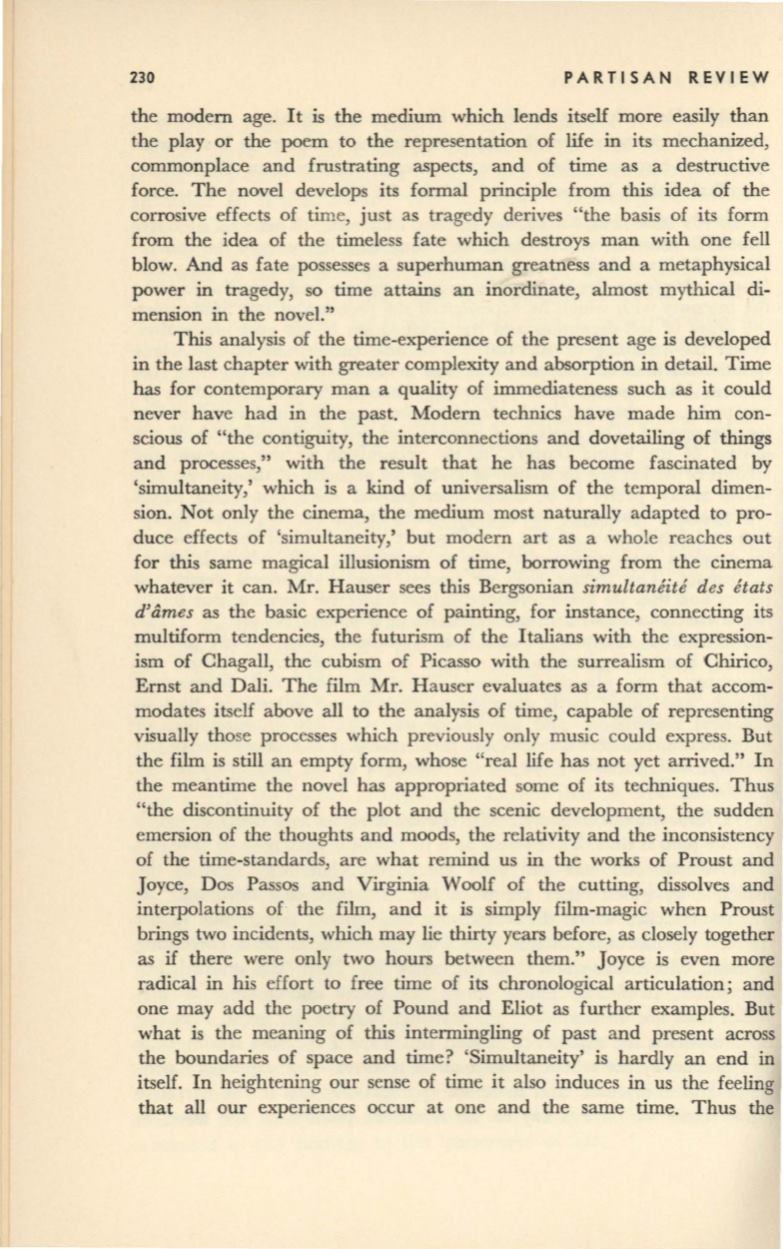
230
PARTISAN REVIEW
the modern age. It is the medium which lends itself more easily than
the play or the poem to the representation of life in its mechanized,
commonplace and frustrating aspects, and of time as a destructive
force. The novel develops its formal principle from this idea of the
corrosive effects of time, just as tragedy derives "the basis of its form
from the idea of the timeless fate which destroys man with one fell
blow. And as fate possesses a superhuman greatness and a metaphysical
power in tragedy, so time attains an inordinate, almost mythical di–
mension in the novel."
This analysis of the time-experience of the present age is developed
in the last chapter with greater complexity and absorption in detail. Time
has
for contemporary man a quality of immediateness such as it could
never have had in the past. Modern technics have made him con–
scious of "the contiguity, the interconnections and dovetailing of things
and processes," with the result that he has become fascinated by
'simultaneity,' which is a kind of universalism of the temporal dimen–
sion. Not only the cinema, the medium most naturally adapted to pro–
duce effects of 'simultaneity,' but modern art as a whole reaches out
for this same magical illusionism of time, borrowing from the cinema
whatever it can. Mr. Hauser sees this Bergsonian
simultaneite des etats
d'ames
as the basic experience of painting, for instance, connecting its
multiform tendencies, the futurism of the Italians with the expression–
ism of Chagall, the cubism of Picasso with the surrealism of Chirico,
Ernst and Dali. The film Mr. Hauser evaluates as a form that accom–
modates itself above all to the analysis of time, capable of representing
visually those processes which previously only music could express. But
the film is still an empty form, whose "real life has not yet arrived." In
the meantime the novel has appropriated some of its techniques. Thus
"the discontinuity of the plot and the scenic development, the sudden
emersion of the thoughts and moods, the relativity and the inconsistency
of the time-standards, are what remind us in the works of Proust and
Joyce, Dos Passos and Virginia Woolf of the cutting, dissolves and
interpolations of the film, and it is simply film-magic when Proust
brings two incidents, which may lie thirty years before, as closely together
as if there were only two hours between them." Joyce is even more
radical in his effort to free time of its chronological articulation; and
one may add the poetry of Pound and Eliot as further examples. But
what is the meaning of this intermingling of past and present across
the boundaries of space and time? 'Simultaneity' is hardly an end in
itself. In heightening our sense of time it also induces in us the feeling
that all our experiences occur at one and the same time. Thus the


